by Angela Levine and Cynthia Shoham
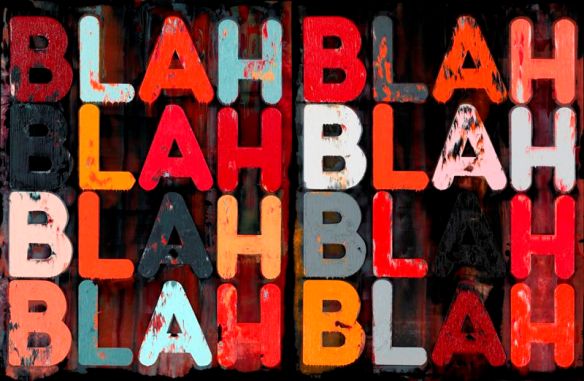
Blah, Blah, Blah – these words dripped in large capitals onto velvet greeted our arrival at About Stupidity, an exhibition in which 15 international stars are participating, together with six artists from Israel. But let’s put the record straight: Mel Bochner, the creator of the first artwork to meet one’s eye, is anything but stupid. A pioneer of conceptual art, he has employed language, typography and color for many decades – as he does here – in order to make us think about words, their meaning and how it affects us.
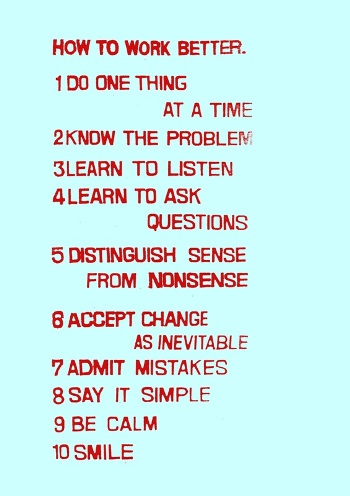
Language is also a major component of works where a ‘silly’ veneer conceals a serious message, or at least provides food for thought. Peter Fischli and David Weiss‘ How to Work Better (1992), for instance, which comprises a printed list of 10 simplistic tips that the artists originally saw on a factory wall in Thailand; or Dan Perjovschi‘s boisterous commentary on current events spread, graffiti-like, over one long gallery wall. Here, phrases with double meanings join cartoon figures to represent life in Israel and the political situation as interpreted by the artist. This is a local version of a number of similar site-specific installations that Perjovschi has created on Museum walls around the world.
Equally eye-catching but requiring much closer study is Proud to be Stupid, Nedko Solakov‘s delicate set of paintings in ink and wash. Alongside small figures, abstracts shapes and wispy lines, Solakov has appended nonsensical, but very funny comments such as “Now I’m dead and see a light at the end of the tunnel, does that mean I’ll be smarter?”
Hey Guys! It is time to Confess our Rudeness, Lust and Narcissim, the title of Vadim Zakharov‘s presentation is essential to the understanding of his wall work where a collection of black Fedora hats hang next to photographs of an ornate crucifix, or (what looks like) the grille of a confessional box. Taking his title and his imagery together, Zakharov appears to be alluding to the casual way that many people relate to religion today, its attractions vying for attention with a football match or a drink at the pub.
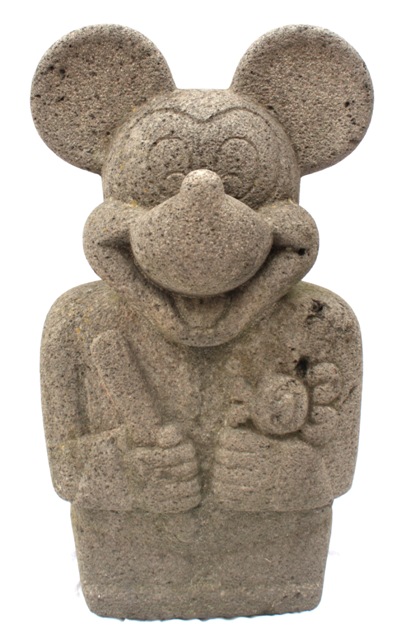
There are nonsensical aspects to all the sculptural installations: Eliezer Sonnenschein‘s dysfunctional tower, for instance, where the building blocks are mirrors stuck into picture frames; and Zoya Cherkassky‘s witty transmogrification of Henry Moore’s Reclining Woman into a fiberglass bathing belle. But Nadin Ospina‘s Idol with Doll, a stone sculpture amalgamating a Pre-Columbian statue with Mickey Mouse, an American icon, may look cute, but this work has weighty connotations. Through it, Ospin is relating to the phenomenon of mass immigration from Columbia to the USA, and the fact that these new immigrants may lose their self-identity and abandon their cultural heritage.
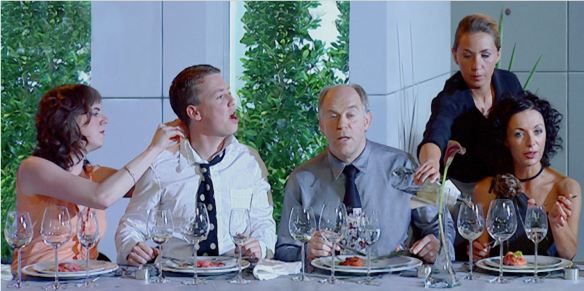
It was worth coming to this show just to see the video films selected by curators Doreet Le Vitte Harten and Diana Dallal. Among them is Op de Beeck‘s tragi-comic All together Now…, filmed at a wedding where the guests have sat down to eat. With the camera and the sound track at slow speed, facial expressions and gestures come under particular scrutiny revealing those signs of false bonhomie and strain that are characteristic of so many family gatherings. Also worth viewing is British comics Dawn French and Jennifer Saunders visit to London’s Tate Museum. Dressed up as two dowdy elderly women, they trail through the galleries bewildered by the art, their sole aim being to locate the cafeteria as soon as possible.
Election Night (2007), A two-channel video projection by Los Torreznos (Rafael Lamata and Jaime Vallaure), lampooning the power and intellectual capacity of politicians was first shown in the Spanish pavilion of the Venice Art Biennale. It has arrived in Israel at just the right time. Against a white backdrop, Lamata and Vallaure are seated in chairs facing their audience. First there is silence, and then intermittently, they begin to chant and distort the names of world leaders, their voices rising to a crescendo. As they shout, they gesticulate wildly. And then there is silence and they start again. This performance recalls a saying by Napoleon Bonaparte that stupidity in politics is not a handicap.
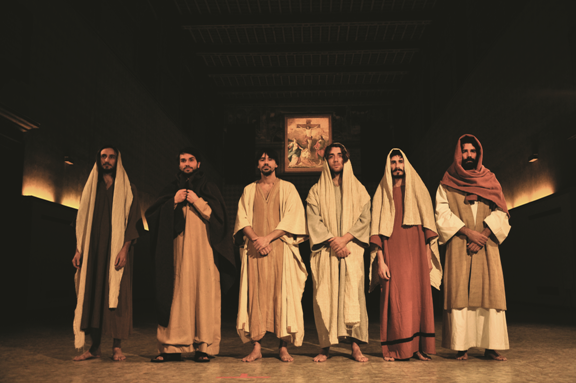
Contemporary foolishness appears to be one of the underlying messages in Christian Jankowski’s standout video piece Casting Jesus in which a panel of judges from the Vatican has been brought in to decide what a modern day Jesus would look like and how would he behave. While there is certainly humor here, one doesn’t get the impression that the artist was aiming to ridicule the Church, but rather to illuminate the cultural emptiness of a society for whom reality games are preferred viewing.
It seems a breach of good taste (I wouldn’t like to say stupidity) for the curators to have positioned Tum Tum, Gil Yefman‘s roly-poly creature, in a space adjacent to the Jesus viewing room. This thing, a crocheted object composed of breasts and genitals, is programmed to intermittently burp and pass wind and these undignified sounds penetrate the room where the video is showing.
Shakespeare had a fitting comment for every occasion. A phrase from his Midsummer Nights Dream, partly appropriated by Miri Segal and presented as a neon-lit wall piece, provides the end-note to this high quality show: Lord what fools these (mortals be.)
Also on display are works by Paul McDevitt, Tom Friedman, Koken Ergun, Sigmar Polke, Uri Katzenstein, David Ginton, Ravit Mishli and Ohad Meromi,
Petach Tikva Museum of Art, 30 Arlozorov St, Petah Tikva. Till April 2012





